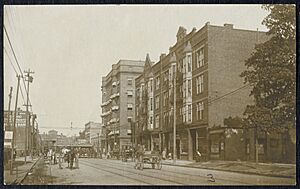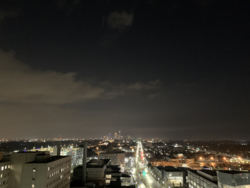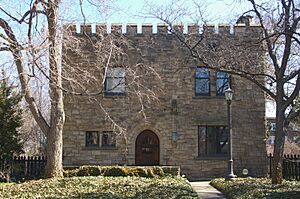Hough, Cleveland facts for kids
Quick facts for kids
Hough
|
|
|---|---|
|
Neighborhood of Cleveland
|
|
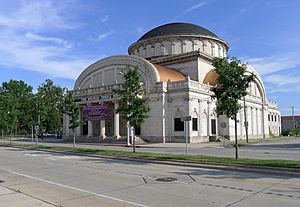
True Holiness Temple on Euclid Avenue, located on the border between Hough and Fairfax neighborhoods.
|
|
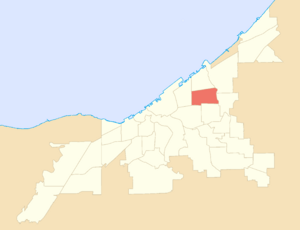
Location in the city of Cleveland
|
|
| Country | United States |
| State | Ohio |
| County | Cuyahoga County |
| City | Cleveland |
| Population
(2020)
|
|
| • Total | 10,755 |
| Demographics | |
| • White | 7.6% |
| • Black | 88.4% |
| • Hispanic (of any race) | 2% |
| • Asian and Pacific Islander | 1.5% |
| • Mixed and Other | 2.5% |
| Time zone | UTC-5 (EST) |
| • Summer (DST) | UTC-4 (EDT) |
| ZIP Codes |
parts of 44106, 44103
|
| Area code(s) | 216 |
| Median income | $19,003 |
| Source: 2020 U.S. Census, Cleveland City Planning Commission | |
Hough (say it like "huff") is a neighborhood on the East Side of Cleveland, Ohio. It covers about two square miles. The neighborhood is located between Superior and Euclid Avenue. Its borders are East 55th and East 105th streets. Hough is found between Downtown Cleveland and University Circle. It shares borders with Fairfax and Cedar–Central to the South. To the North, it borders Glenville and St. Clair–Superior. This area became a focus for rebuilding in the mid-1900s. This happened after the 1966 Hough Riots.
Contents
Hough's Story: A Cleveland Neighborhood's History
Early Days of Hough
Hough is one of Cleveland's oldest neighborhoods. It was named after Oliver and Eliza Hough. They were the first to settle there in 1799. The area officially became part of Cleveland in 1873.
At the start of the 1900s, Hough was a home for wealthy white families. Important local families like the Severances lived here. Their homes were as grand as those on Millionaire's Row. Businesses also started up around this time. The Warner & Swasey Company began in 1881. Other businesses included the Doan's Corner Shopping District. This was on East 105th Street. Hough Bakery was also popular. It was near East 87th Street on Hough Avenue.
After World War I, many wealthy families moved away. The neighborhood then became home to mostly working-class European families. Hough also lost some important places. University School moved to Shaker Heights. League Park, the original home of the Cleveland Indians baseball team, was also left. The Indians slowly moved to Cleveland Municipal Stadium in Downtown.
The Great Depression made things harder for Hough. There wasn't enough housing for everyone. Single-family homes were turned into multi-family homes. Fewer people owned their homes.
Hough Becomes an African American Community
By 1960, Hough had become a mostly African American community. Many factors led to this change. The Second Great Migration brought many Black people to Cleveland. Also, old neighborhoods like Cedar-Central were cleared. This caused a large number of Black residents to move into Hough.
Other city projects also played a role. New highways were built through communities. This also displaced residents. From 1957 to 1962, the city had a project called University-Euclid. It tore down houses in Eastern Hough. But not enough new homes were built. This led to overcrowding in Hough. Landlords kept turning large homes into multi-family units.
The increase in African American residents led to "blockbusting." This is when real estate agents scared white homeowners. They told them that Black families moving in would lower property values. This caused "panic selling" and "white flight" to the suburbs.
The huge population growth strained the school system. Schools had to create half-day groups. They also started busing students to white neighborhoods. This included places like Murray Hill. Busing was very controversial. It led to challenges for Black students from Hough and Glenville.
In 1966, the Cleveland Press newspaper called Hough a "powder keg." This was just months before the Hough Riots. They said racial tensions were high. The neighborhood gained national attention. Protests happened for five days, from July 18th to July 23rd.
Rebuilding Hough: Efforts to Improve the Neighborhood
Stokes Administration's Efforts
After the 1966 uprising, the Hough Area Development Corporation (HADC) was formed. Civil rights activist Reverend Deforest Brown started it. They used money from the "Cleveland: NOW!" program. This program was part of Carl Stokes' administration. Stokes was Cleveland's first Black mayor. The HADC worked to fund housing and jobs in Hough.
One project was Martin Luther King Jr. Plaza. It was a building with both homes and stores. The HADC also helped Black businesses in the community. They offered job training. The HADC and a group called Operation Black Unity helped create Black-owned McDonald's restaurants. This happened after a boycott in 1969. Even though these McDonald's franchises struggled later, their effort was important. It helped other Black-owned businesses start in inner cities.
Mayor Stokes also worked with Cleveland Pride, another Black nationalist group. In 1968, they planted sod in the neighborhood. This was a symbolic way to make Hough look better.
Hough in the 21st Century
Today, Hough is seeing more redevelopment. It is still one of Cleveland's poorer neighborhoods. One important project was the preservation of League Park in 2014. This $6.3 million effort rebuilt the old baseball diamond. It now has an AstroTurf field. The old ticket office became a Baseball Heritage Museum.
Hough is part of the city's 7th Ward. Councilwoman Stephanie Howse represents the area.
Important Places in Hough
Hough is home to several historical places:
- The Crawford-Tilden Apartments are on East 84th Street and Crawford. They were built in 1908. These apartments are listed on the National Register of Historic Places. They are also a Cleveland Designated Landmark.
- League Park is on East 66th Street and Lexington Avenue. It was the original baseball park for the Cleveland Spiders/Indians. It was also home to the Negro League's Cleveland Buckeyes. Most of the stadium was torn down in the 1950s. But the baseball diamond is now part of a public park.
- The The East 89th Street Historic District is a small residential area. It is between Chester and Hough Avenue. It has colonial revival style homes. These homes show how wealthy residents lived in Hough around 1900.
- The Charles F. Schweinfurth Residence is near Chester and East 75th Street. This was the home of a famous Cleveland architect. It was first built for a member of the Vanderbilt family. The building looks like a castle. After Schweinfurth died, it was a funeral home from 1930 to 1970. Then, it was bought and saved in the 1970s. This was part of a bigger effort to improve the area.


